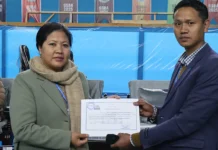[ Geetha VO ]
Learning is popularly regarded as the process of acquiring new knowledge, behaviour, skills, values, or understanding, and may involve synthesizing different types of information. This activity of learning is sometimes conscious and sometimes unconscious, sometimes fast and sometimes slow, but there is hardly an occasion in a person’s life when it stops completely.
Learning disability refers to a number of disorders which may affect the acquisition, organisation, retention, understanding or use of verbal or nonverbal information. These disorders affect learning in individuals who otherwise demonstrate at least average abilities essential for thinking and/or reasoning. As such, learning disabilities are distinct from global intellectual deficiency.
Concept of LD
International studies show that 10 percent of school-going children have a learning disability (LD). A paper published by the National Institute of Mental Health & Neurosciences (NIMHANS) in 2002 also supported this fact by saying that 5-10 percent of the children in India are dyslexic. Hallahan and Kauffman (1976) define that a learning-disabled child is one who is not achieving her or his potential.
Learning disability is defined as the brain’s inability to receive, process, analyze or store information. By definition, individuals with a learning disability have near normal to normal intelligence. Such individuals may have difficulty in reading or writing.
Learning disabilities are described as being of two main types: verbal and nonverbal. People with verbal LD have difficulty with words, both spoken and written. A learning disability is seen on a functional and behavioural level, in the slow or abnormal learning of new skills. Among school-aged children, such difficulties may be seen as deficient skills in reading, spelling and writing, reading comprehension, mathematics, problem-solving, and attention.
Learning disability results from impairment in one or more process related to preserving thinking, remembering or learning. These include, but are not limited to, language processing, phonological processing, visual spatial processing, presenting speed and memory.
Learning disability is a neurological disorder. In simple terms, learning disability results from the difference in the way a person’s brain is wired. Children with learning disabilities are as smart as or smarter than their peers. The disability may vary over an individual’s lifetime, depending on the interaction between the demands of the environment and the individual strength and needs. Learning disabilities are suggested by unexpected academic underachievement, or achievement which is maintained only by unusually high level of effort and sport.
Learning disabilities are due to genetic and neurological factors or injury that alters the brain’s functioning in a manner which affects one or more process related to learning. These disorders are not due primarily to hearing and visual problems, socioeconomic factors, cultural and linguistic differences, lack of motivation or ineffective teaching. However, these factors further complicate the challenges faced by individuals with learning disabilities.
Learning disabilities may coexist with various conditions, including attention, behavioral and emotional disorders, sensory impairment, or other medical conditions or attention deficit disorder (ADD) and attention deficit hyperactive disorder (ADHD).
Common symptoms of LD
1. Trouble in following directions.
2. Clumsiness.
3. Poor memory.
4. Problem in giving attention.
5. Problem in staying organized.
6. Speaking like a young child.
7. Problem in reading and writing.
8. Problem with doing mathematics.
Types of LD
Learning disability is of mainly four types:
1. Dyslexia – difficulty in reading.
2. Dysgraphia – difficulty in writing.
3. Dyscalculia – difficulty in arithmetic.
4. Dyspraxia – difficulty in practicing due to lack of motor coordination.
Dyslexia
Dyslexia, also known as reading disorder, is characterized by trouble with reading despite normal intelligence. Different people are affected to varying degrees. Problems may include difficulties in spelling words, reading quickly, writing words, ‘sounding out’ words in the head, pronouncing words when reading aloud and understanding what one reads. Often, these difficulties are first noticed at school.
The underlying mechanisms of dyslexia are problems within the brain’s language processing. Dyslexia is diagnosed through a series of tests of memory, spelling, vision, and reading skills. Dyslexia is separate from reading difficulties caused by hearing or vision problems or by insufficient teaching.
Dysgraphia
Dysgraphia is a deficiency in the ability to write, primarily handwriting, but also coherence. The word ‘dysgraphia’ comes from the Greek words ‘dys’, meaning ‘impaired’, and ‘graphía’, meaning ‘writing by hand’. Dysgraphia is a transcription disability, meaning that it is a writing disorder associated with impaired handwriting, orthographic coding (the storing process of written words and processing the letters in those words), and finger sequencing (the movement of muscles required to write). It often overlaps with other learning disabilities such as speech impairment, ADD, or developmental coordination disorder.
Dysgraphia is characterized as a learning disability in the category of written expression, when one’s writing skills are below those expected, given a person’s age measured through intelligence and age-appropriate education.
Dyscalculia
The most generally agreed upon feature of children with dyscalculia is difficulty in learning and remembering arithmetic facts. A second feature of children with dyscalculia is difficulty in executing calculation procedures, with immature problem-solving strategies, long solution times, and high error rates… Researchers, then, agree that dyscalculia manifests itself as a problem in learning arithmetic facts and calculation procedures.
Working memory in dyscalculic children should control both reading ability and general IQ. Children with arithmetic difficulties only were more likely to have difficulties with spatial and psychomotor abilities. Another set of deficits which are associated with developmental dyscalculia are finger agnosia, dysgraphia, and difficulties with left-right discrimination.
Dyspraxia
A disorder that is characterized by difficulty in muscle control, which causes problems with movement and coordination, language and speech, and can affect learning. Although not a learning disability, dyspraxia often exists along with dyslexia, dyscalculia or ADHD.
Deficits in any area of information processing can manifest in a variety of specific learning disabilities. It is possible for an individual to have more than one of these difficulties. This is referred to as co-morbidity or co-occurrence of learning disabilities. In the UK, the term ‘dual diagnosis’ is often used to refer to co-occurrence of learning difficulties.
Some facts about LD
A learning disability cannot be cured or fixed. It is a lifelong issue. With the right support and intervention, however, children with learning disabilities can succeed in schools and go on to have successful, often distinguished careers later in life.
For success, individuals with learning disability require identification and timely specialized assessment and intervention involving home, school, community and workplace settings. The intervention needs to be appropriate for each individual’s learning disabilities sub-type and, at a minimum, include the provision of (a) specific skill instructions, (b) accommodation, (c) compensatory strategies, and (d) self-advocacy skills.
Individuals with learning disabilities can face unique challenges that are often pervasive throughout their lifespan. Depending on the type and severity of the disability, interventions and current technologies may be used to help the individual learn strategies that will foster future success.
Some interventions can be quite simplistic, while others are intricate and complex. Current technologies may require student training to be effective classroom support. Teachers, parents and schools can create plans together that tailor intervention and accommodation to aid the individuals in successfully becoming independent learners. School psychologists and other qualified professionals quite often help design the interventions and coordinate in the execution of the intervention with teachers and parents. Social support may improve the learning for students with learning disabilities.
Conclusion
1. Learning disability is a hidden handicapped condition.
2. LD children have average or above average intelligence.
3. LD is a condition, not a disease.
4. Correct diagnosis and early intervention minimize the difficulty.
5. Remedial education helps the child to cope up with the problem effectively.
6. Highlight their skills rather than skill deficits.
Learning-disabled children demand: ‘If I can’t learn the way you teach, teach me the way I can learn.’ (The contributor is a teacher at Government Upper Primary School, Mowb-II. She won a state award in 2018.)



